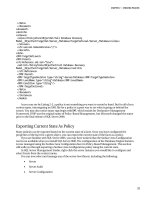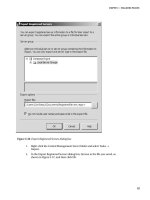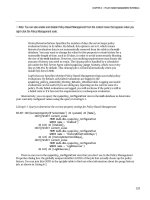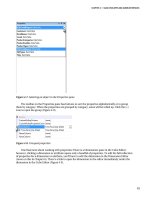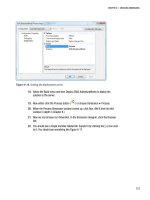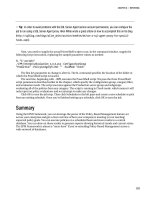Pro SQL Server 2008 Administration pptx
Bạn đang xem bản rút gọn của tài liệu. Xem và tải ngay bản đầy đủ của tài liệu tại đây (14.68 MB, 594 trang )
spine = 1.09375" 592 page count
Simmons
Carstarphen
Pro SQL Server 2008 Administration
Companion
eBook
Available
THE EXPERT’S VOICE
®
IN SQL SERVER
Pro
SQL Server 2008
Administration
Ken Simmons
and Sylvester Carstarphen
A real-world guide providing productive
and proactive database administration
techniques for SQL Server 2008.
this print for content only—size & color not accurate
BOOKS FOR PROFESSIONALS BY PROFESSIONALS
®
Pro SQL Server 2008 Administration
Dear Reader,
SQL Server has become such a broad product with so many features that it can
seem overwhelming at times. Database administrators today need to be up to
speed on a broad variety of topics and technologies, spanning the gamut from
auditing in support of regulatory compliance to high-availability technologies
like mirroring and clustering. Soft skills are important, too. In a single day, you
might go from a query optimization problem in the morning to a meeting with
executives in the afternoon. One minute you’re buried in the minutiae of SQL,
and the next you’re at the 10,000-foot level planning for future growth.
You need an edge. We’ve spent countless hours throughout our careers build-
ing our administration skills. We know that sometimes the hardest part of learn-
ing something is figuring out what to learn, and that’s why we wrote this book.
We aim to provide you with the information necessary to be a successful data-
base administrator by focusing on the core concepts required to administer and
manage SQL Server. We cover the foundational topics that you expect, such as
installation, index creation, and backup and recovery. We talk about the new
features available in SQL Server 2008 that will make your job easier. We cover
soft skills in our chapter on excelling as a SQL Server administrator. In addi-
tion, we cover some of the latest business- and regulatory-driven topics, such
as auditing and managing security.
Database administration is a tough job. But its demanding nature and the
occasional, crisis-induced adrenaline rush are part of what make the job so fun
and rewarding. We wrote Pro SQL Server 2008 Administration to help prepare
you for the challenge—to help you design and create a database environment
that will stand up under stress. We want you to succeed, just as we have in our
own careers. We hope you enjoy reading Pro SQL Server 2008 Administration as
much as we have enjoyed writing it.
Sincerely,
Ken Simmons and Sylvester Carstarphen
Ken Simmons
US $49.99
Shelve in
Databases/SQL Server
User level:
Intermediate–Advanced
CYAN
MAGENTA
YELLOW
BLACK
PANTONE 123 C
THE APRESS ROADMAP
Beginning SQL Server
2008 Administration
Pro SQL Server 2008
Administration
Pro SQL Server
2008 Failover Clustering
www.apress.com
SOURCE CODE ONLINE
Companion eBook
See last page for details
on $10 eBook version
ISBN 978-1-4302-2373-3
9 781430 223733
54999
Sylvester Carstarphen
Pro SQL Server 2008
Administration
Ken Simmons and Sylvester Carstarphen
Pro SQL Server 2008 Administration
Copyright © 2009 by Ken Simmons and Sylvester Carstarphen
All rights reserved. No part of this work may be reproduced or transmitted in any form or by any means,
electronic or mechanical, including photocopying, recording, or by any information storage or retrieval
system, without the prior written permission of the copyright owner and the publisher.
ISBN-13 (pbk): 978-1-4302-2373-3
ISBN-13 (electronic): 978-1-4302-2374-0
Printed and bound in the United States of America 9 8 7 6 5 4 3 2 1
Trademarked names may appear in this book. Rather than use a trademark symbol with every occurrence
of a trademarked name, we use the names only in an editorial fashion and to the benefit of the trademark
owner, with no intention of infringement of the trademark.
Lead Editor: Jonathan Gennick
Technical Reviewer: Rodney Landrum
Editorial Board: Clay Andres, Steve Anglin, Mark Beckner, Ewan Buckingham, Tony Campbell, Gary Cor-
nell, Jonathan Gennick, Michelle Lowman, Matthew Moodie, Jeffrey Pepper, Frank Pohlmann, Ben
Renow-Clarke, Dominic Shakeshaft, Matt Wade, Tom Welsh
Project Manager: Beth Christmas
Copy Editor: Kim Benbow
Associate Production Director: Kari Brooks-Copony
Production Editor: Laura Esterman
Compositor: Jill Flores
Proofreader: Kim Burton
Indexer: Becky Hornyak
Artist: April Milne
Cover Designer: Kurt Krames
Manufacturing Director: Tom Debolski
Distributed to the book trade worldwide by Springer-Verlag New York, Inc., 233 Spring Street, 6th Floor,
New York, NY 10013. Phone 1-800-SPRINGER, fax 201-348-4505, e-mail , or
visit .
For information on translations, please contact Apress directly at 2855 Telegraph Avenue, Suite 600,
Berkeley, CA 94705. Phone 510-549-5930, fax 510-549-5939, e-mail , or visit http://www.
apress.com.
Apress and friends of ED books may be purchased in bulk for academic, corporate, or promotional use.
eBook versions and licenses are also available for most titles. For more information, reference our Special
Bulk Sales–eBook Licensing web page at />The information in this book is distributed on an “as is” basis, without warranty. Although every precau-
tion has been taken in the preparation of this work, neither the author(s) nor Apress shall have any liability
to any person or entity with respect to any loss or damage caused or alleged to be caused directly or indi-
rectly by the information contained in this work.
The source code for this book is available to readers at .
I want to dedicate this book to my wife Susan and son Nathan. Writing a book takes a lot
of time and hard work, and they have definitely given me the support and encouragement I
needed throughout the process.
—Ken Simmons
This book is dedicated to my loving wife, Kimberly, who motivated me when I was tired,
encouraged me when I was down, and never complained when I spent all weekend writing.
Thanks for all of your support. I love you.
—Sylvester Carstarphen
iv
Contents at a Glance
About the Authors xix
About the Technical Reviewer xx
Acknowledgments xxi
Introduction xxiii
PART 1
■ ■ ■
Introducing Microsoft SQL Server
2008
CHAPTER 1 New Feature Overview 3
CHAPTER 2 Pre-Installation Considerations 21
CHAPTER 3 Choosing a High-Availability Solution 43
PART 2
■ ■ ■
Getting Started
CHAPTER 4 Installing Microsoft SQL Server 2008 69
CHAPTER 5 Upgrading to Microsoft SQL Server 2008 111
CHAPTER 6 Post-Installation 143
PART 3
■ ■ ■
Administering Microsoft SQL Server
2008
CHAPTER 7 Multi-Server Administration 177
CHAPTER 8 Managing Security Within the Database Engine 209
CHAPTER 9 Administering Database Objects 251
CHAPTER 10 Indexing for Performance 297
CHAPTER 11 Managing Backups 343
CHAPTER 12 Restore and Recovery Strategies 371
CHAPTER 13 Automating Routine Maintenance 413
■CONTENTS AT A GLANCE
v
PART 4
■ ■ ■
Troubleshooting and Tuning
CHAPTER 14 Monitoring Your Server 451
CHAPTER 15 Auditing SQL Server 479
CHAPTER 16 Managing Query Performance 495
PART 5
■ ■ ■
Conclusion
CHAPTER 17 Secrets to Excelling As a Professional DBA 527
CHAPTER 18 What’s Next? 537
INDEX 545
vii
Contents
About the Authors xix
About the Technical Reviewer xx
Acknowledgments xxi
Introduction xxiii
PART 1
■ ■ ■
Introducing Microsoft SQL Server
2008
CHAPTER 1 New Feature Overview 3
Scalability Enhancements 4
Filtered Indexes and Statistics 4
Table and Query Hints 5
Query Performance and Processing 5
Manageability Enhancements 5
Auditing 6
Change Data Capture 6
Change Tracking 6
Backup Compression 6
Data Collector 7
Central Management Servers 7
Policy-Based Management 7
Resource Governor 8
PowerShell 8
Availability Enhancements 8
Database Mirroring 8
Clustering 9
Peer-to-Peer Replication 9
Hot-Add CPU 9
Programmability Enhancements 10
Variables 10
Transact-SQL Row Constructors 11
■CONTENTS
viii
Table-Valued Parameters 12
MERGE Statement 14
GROUPING SETS Operator 17
Security Enhancements 20
Transparent Data Encryption 20
Extensible Key Management 20
Summary 20
CHAPTER 2 Pre-Installation Considerations 21
Choosing a SQL Server Edition 21
Enterprise Edition 22
Standard Edition 23
Developer Edition 24
Workgroup Edition 25
Web Edition 25
Express Edition 26
Determining Hardware Requirements 27
Determining CPU Needs 29
Disk Subsystems 31
Database Sizing 32
Determining RAID Levels 34
Final Disk Storage Configuration 36
Determining Memory Requirements 36
Choosing the Server 37
SQL Server Consolidation 38
Consolidation with Virtual Servers 40
Summary 41
CHAPTER 3 Choosing a High-Availability Solution 43
What Exactly Is High Availability Anyway? 43
Failover Clustering 44
Key Terms 44
Failover Clustering Overview 45
Pros and Cons of Failover Clustering 48
Database Mirroring 48
Key Terms 48
Database Mirroring Overview 49
High-Safety Mode 50
■CONTENTS
ix
High-Performance Mode 51
Pros and Cons of Database Mirroring 52
Copying Data with Log Shipping 53
Key Terms 53
Log Shipping Overview 54
Pros and Cons of Log Shipping 56
Making Data Available Through Replication 56
Key Terms 57
Replication Overview 57
Snapshot Replication 58
Transactional Replication 59
Merge Replication 62
Pros and Cons of Replication 63
Other High-Availability Techniques 64
High Availability Feature Comparison 64
Summary 65
PART 2
■ ■ ■
Getting Started
CHAPTER 4 Installing Microsoft SQL Server 2008 69
User Accounts 70
Preparation and Prerequisites 70
SQL Server Installation Center 71
Planning 72
Installation 73
Maintenance 74
Tools 75
Resources 76
Advanced 77
Options 77
Installing Your First Instance 78
Checking System Configuration 79
Choosing Your Features 81
Configuring the Instance 82
Configuring the Database Engine 84
Allowing for Error and Usage Reporting 86
Validating and Installing 87
■CONTENTS
x
Installing More Than One Instance 90
Preparing to Install Another Instance 90
Getting Your System Ready 90
Configuring the Instance 93
Command-Line Installation 95
Learning the Parameters 96
Passing Parameters to the Installer 98
Running a Command-Line Install 98
Configuration File Installation 104
Summary 110
CHAPTER 5 Upgrading to Microsoft SQL Server 2008 111
Upgrade Tools 111
Microsoft SQL Server 2008 Upgrade Advisor 111
Upgrade Assistant 118
SQL Server Integration Services 119
Running DTS in SQL Server 2008 119
DTS Package Migration Wizard 119
Upgrade Strategies 120
In-Place Upgrade 121
Side-by-Side Upgrade 128
Post-Upgrade Procedures 138
Changing Compatibility Level 139
Checking Object Integrity 139
Correct Row and Page Counts 140
Setting the Page Verification Method 140
Updating Statistics 140
Summary 141
CHAPTER 6 Post-Installation 143
SQL Server Configuration Manager 143
SQL Server Services 144
SQL Server Network Configuration 148
SQL Native Client Configuration 154
Configuring the Instance 157
Viewing Advanced Options 157
Viewing Configuration Settings 157
Specifying Maximum and Minimum Server Memory 161
Enabling Address Windows Extensions 163
■CONTENTS
xi
Specifying the Backup Compression Default 163
Enabling Login Failure Auditing 165
Enabling Dedicated Administrator Connections 166
Disabling Default Trace 166
Enabling Use of the CLR (Common Language Runtime) 166
Choosing Lightweight Pooling 167
Enabling a Query Governor Cost Limit 167
xp_cmdshell 168
Miscellaneous Configuration Options 168
Preproduction Tasks 170
Server Tasks 170
Database Tasks 170
Maintenance and Monitoring 172
Summary 173
PART 3
■ ■ ■
Administering Microsoft SQL Server
2008
CHAPTER 7 Multi-Server Administration 177
Policy-Based Management 177
Manually Creating a Policy 178
Exporting Current State As Policy 185
Importing a Predefined Policy 187
Central Management Servers 189
Running Multi-Server Queries 193
Configuring Multi-Server Query Options 194
Evaluating Policies 196
SQL Dependency Reporting 199
Summary 207
CHAPTER 8 Managing Security Within the Database Engine 209
Security Language 209
Principals 210
Securables 211
Schemas 211
Creating SQL Server Principals 211
Creating Logins for SQL Server 211
Creating SQL Server Logins for Windows Principals 212
■CONTENTS
xii
Creating SQL Server–Authenticated Logins 213
Associating Logins with Certificates and Asymmetric Keys 213
Linking Credentials to Logins 214
SQL Server–Level Roles 215
Database Security 216
Creating Database Users 217
Database Roles 218
Application Roles 220
Securables 220
Managing Server Securables 220
Managing Database Securables 221
Understanding Schema Securables 222
Permissions 225
Types of Permissions 225
Permission Grouping 226
Managing Permissions 226
GUI Security Administration 227
Creating a User 227
Creating Roles 234
Creating Schemas 239
Encryption 242
Encrypting Data Using Certificate Encryption 242
Encrypting Data Using Asymmetric Keys 244
Encrypting Data Using Symmetric Keys 246
Extensible Key Management 247
Transparent Data Encryption 248
Summary 249
CHAPTER 9 Administering Database Objects 251
Database 101 251
Working with System Databases 252
Working with Database Snapshots 253
Creating a Database Snapshot 254
Viewing and Querying a Snapshot 255
Reverting a Database to a Database Snapshot 256
Working with Tables 257
Default Constraints 257
Primary Key Constraints 259
Unique Constraints 261
Foreign Key Constraints 262
■CONTENTS
xiii
Check Constraints 264
Sparse Columns 266
Compression 267
Partitions 269
Temporary Tables 271
Working with Views 272
Partitioned Views 274
Updateable Views 275
Indexed Views 276
Working with Synonyms 277
Working with Stored Procedures 280
Working with Functions 286
Scalar-Valued Functions 286
Table-Valued Functions 287
Working with Triggers 290
DML Triggers 290
DDL Triggers 291
Logon Triggers 292
Working with the Common Language Runtime 293
Summary 295
CHAPTER 10 Indexing for Performance 297
Index Vocabulary, Structure, and Concepts 297
Heaps 297
Clustered Indexes 297
Nonclustered Indexes 298
Structure of Indexes and the Heap 298
Indexes Created by Constraints 301
Other Ways to Categorize Indexes 302
Other Index Concepts and Terminology 303
Creating Indexes via T-SQL 304
Creating Clustered and Nonclustered Indexes 304
Creating Unique and Primary Key Indexes 309
Creating Filtered Indexes 310
Creating XML Indexes 314
Creating Indexes Using the GUI 316
Creating an Example Table 316
Creating a Clustered Index via the GUI 317
Creating a Nonclustered Index via the GUI 322
■CONTENTS
xiv
Post-Index Creation 324
Performance of Insert, Update, and Delete Statements 325
Useful Dynamic Management Views 326
Putting It All Together 329
Setting Up the Scenario 329
Table Scans 330
Clustered Index Seeks 331
Covering Your Queries 333
Indexing JOIN Criteria 337
Filtered Indexes 339
Summary 341
CHAPTER 11 Managing Backups 343
Recovery Models 343
Backup Architecture 344
Backup Types 346
Full Backups 346
Differential Backups 347
Transaction Log Backups 349
Partial Backups 350
File Backups 351
Copy-Only Backups 352
Backup Compression 353
Logical Backup Devices 355
The GUI Backup Interface 358
Backups from T-SQL 364
Using Encryption 366
Backing Up the System Databases 367
Backup History 369
Summary 370
CHAPTER 12 Restore and Recovery Strategies 371
Restore Vocabulary 371
The Importance of Recovery Models 372
Practicing Your Recovery Strategy 373
Types of Restores 374
Restoring Full Backups 376
Restoring Transaction Logs 376
Restoring Differential Backups 377
■CONTENTS
xv
Restoring Files and Filegroups 378
Restoring Pages 380
Piecemeal Restores 380
Restoring Snapshots 381
RESTORE HEADERONLY 382
RESTORE FILELISTONLY 382
RESTORE VERIFYONLY 382
Online Recoveries 383
Restore Considerations 383
Utilizing Filegroups for Faster Restores 383
Preparing for Hardware Failures 384
Recovering from Scratch 384
Recovery Examples 385
Example 1: The Piecemeal Restore 386
Backing Up the Tail End of the Transaction Log 389
Example 2: Restoring a Compressed and Encrypted Database 399
Example 3: Restoring System Databases 409
Summary 411
CHAPTER 13 Automating Routine Maintenance 413
Database Mail 413
Database Mail Configuration Wizard 413
Configuring Database Mail Using T-SQL 422
Sending Database Mail 424
Database Mail Cleanup Procedures 425
SQL Server Agent 426
Operators 426
Enabling SQL Server Agent Notifications 427
Alerts 429
Jobs 432
Proxies 439
Maintenance Plans 441
Maintenance Plan Wizard 442
Maintenance Plan Design Tab 443
Maintenance Plan Tasks 444
Exporting and Importing Maintenance Plans 445
Summary 447
■CONTENTS
xvi
PART 4
■ ■ ■
Troubleshooting and Tuning
CHAPTER 14 Monitoring Your Server 451
Baseline Your Server 451
Familiarizing Yourself with the Performance Monitor 452
Monitoring Your CPU 454
Windows Counters That Indicate CPU Utilization 457
SQL Server Counters That Impact CPU 458
DMVs for Monitoring CPU 459
Monitoring Your Memory 462
Memory Usage in SQL Server 462
Counters to Watch 463
Memory with Windows Counters 465
Memory with SQL Server Counters 466
Memory with DMVs and DBCC Commands 467
Monitoring Disk IO 469
Disk IO with Windows Counters 471
Disk IO with SQL Server Counters 471
Monitoring Miscellaneous Counters and DMVs 472
Capturing SQL Server PerfMon Counters Using DMVs 472
Leveraging the SQL Server Profiler 472
Using Server-Side Tracing 475
Automating Your Monitoring 477
Summary 478
CHAPTER 15 Auditing SQL Server 479
Choosing Your Audit Type 479
Creating SQL Server Audits with T-SQL 480
Creating Server Audit Specifications 481
Server-Level Action Groups 481
Testing Your Server Audit Specification 483
Creating Database Audit Specifications 484
Database-Level Audit Action Groups 485
Database-Level Audit Actions 486
Testing Your Database Audit Specification 487
Creating SQL Server Audits Using the GUI 489
Creating a Database Audit Specification Using the GUI 490
Reviewing Audit Files Using SQL Server Management Studio 492
■CONTENTS
xvii
Audit-Related Startup and Shutdown Problems 493
Failure to Start 493
Forced Shutdowns 494
Useful SQL Server Audit Objects 494
Summary 494
CHAPTER 16 Managing Query Performance 495
Correlating Profiler and the Performance Monitor 495
Finding Similar Queries 497
Running the Standard Performance Reports 499
Optimizing for Specific Parameter Values 501
Forcing Index Seeks 504
Forcing a Specific Execution Plan 506
Adding Hints Through Plan Guides 507
Creating a Plan Guide 507
Validating a Plan Guide 509
Managing Resources with the Resource Governor 511
Resource Pools 512
Workload Groups 514
Classifier Function 516
Monitoring Resource Governor 519
Performance Counters 519
Trace Events 520
Views 521
Summary 523
PART 5
■ ■ ■
Conclusion
CHAPTER 17 Secrets to Excelling As a Professional DBA 527
Be Good at What You Do 527
Face Reality 527
Build Your Reputation 528
Go Above and Beyond 529
Communicate Effectively 530
Talk to Your Target Audience 530
Know When They Don’t Care 531
Be a Good Listener 531
■CONTENTS
xviii
Remain Calm Under Pressure 532
Prepare for Pressure Situations 532
Deal with Pressure Situations 532
Wrap Up the Pressure Situation 534
Be an Effective Leader 534
Make Tough Decisions 535
Make Others Around You Better 535
Summary 536
CHAPTER 18 What’s Next? 537
Ongoing Experimentation and Learning 537
Podcasts 538
Free Training Events 538
SQL Support Options 539
Free Support 539
Paid Support 541
Advisory Services 541
Web Sites Dedicated to SQL Server 542
Apress Titles for Specialized Topics 542
Summary 543
INDEX 545
xix
About the Authors
■KEN SIMMONS is a database administrator/developer specializing in
MSSQL Server and .NET. He has been working in the IT industry since
2000 and currently holds certifications for MCP, MCAD, MCSD, MCDBA,
and MCTS for SQL 2005.
Ken is highly active in the in the online community and often par-
ticipates in the SQL forums on MSDN and SQLServerCentral.com. He
enjoys sharing tips by writing articles for SQLServerCentral.com and
MSSQLTips.com. He has also formed a SQL Server users group in
Columbus, Georgia, to provide a local faucet for SQL Server professionals
to come together to share knowledge and resources. When he is not working, Ken enjoys
traveling with his wife Susan and son Nathan, and can often be found on a cruise ship, at a
Disney resort, or at the beach in his hometown of Pensacola, Florida.
■SYLVESTER CARSTARPHEN is a senior database administrator for a CRM
company, where he is leading its performance-tuning efforts on its
VLDBs. Sylvester started his database administration career almost six
years ago at a Fortune 500 company, where he rapidly progressed from
DBAI, DBAII, and senior DBA to manager (working manager) of database
support in four years. His role consisted of managing six SQL Server DBAs
in an environment of 100+ SQL Server instances with 150+ application
databases. In search of opportunities to increase his performance-
monitoring and tuning skills, Sylvester took on a new role with the
CRM company to help solve its major performance issues.
Sylvester possesses a bachelor’s degree in computer science from Wofford College in
South Carolina and a master’s degree in applied computer science with a concentration in
software development from Columbus State University, Georgia. Sylvester enjoys playing
video games and spending time with his wife, Kimberly, and his American Staffordshire terrier.
xx
About the Technical Reviewer
■RODNEY LANDRUM has been working with SQL Server technologies for
longer than he can remember. (He turned 40 in May of 2009, so his mem-
ory is going.) He writes regularly about many SQL Server technologies,
including Integration Services, Analysis Services, and Reporting Services.
He has authored three books on Reporting Services and is working on a
fourth book at present, expanding several popular articles on his DBA
Script Thumb idea. He is a regular contributor to SQL Server Magazine
online, SQLServerCentral.com, and Simple-Talk, the latter of which he
sporadically blogs on about SQL and his plethora of geek tattoos. Rodney
also speaks regularly on SQL topics at such events as SQL Saturday in Florida, his home state.
His day job finds him overseeing the health and well-being of a large SQL Server infrastructure
in Pensacola, Florida. He swears he owns the expression, “Working with databases on a day-
to-day basis,” and anyone who disagrees is itching to lose at an arm-wrestling match.
xxi
Acknowledgments
First of all, I would like to thank Jonathan Gennick for giving me an opportunity to write this
book. He, along with everyone else at Apress, has been really supportive throughout this pro-
cess. Beth Christmas did an awesome job keeping the project on track. She was even able to
push me a little to get the book out sooner than I anticipated. It is unbelievable how Kim
Benbow was able to catch all the little details to make sure the terminology remained consis-
tent throughout the book. I would also like to thank the production editor, Laura Esterman,
and everyone else at Apress who has worked on the book.
I want to thank Sylvester Carstarphen, the coauthor, for stepping in and helping me with
the book. I didn’t want to take on such a large topic by myself, and he improved the book in
many areas by adding his expertise and experience to the mix. I also knew I could count on
him to keep the book on schedule, even if it meant working a lot of late nights and sacrificing
his weekends.
I was also lucky to have Rodney Landrum, a well-known author, MVP, and all-around
smart guy, as a technical reviewer. I have known Rodney for about ten years now, and he was
the first one on my list when Jonathan asked me if I had anyone in mind for a technical editor.
He has done a great job making sure the content is accurate throughout.
Ken Simmons
First and foremost, I have to thank Ken for asking me to work with him on this book. It is an
opportunity of a lifetime and I would still be waiting on such an opportunity if it wasn’t for
him. Ken, I owe you one—a big one.
I would also like to thank all of the DBAs I have worked with over the years. I have learned
a lot from each of you. Specifically, I would like to thank Steven Cush for introducing me to
SQL Server and sharing his DBA knowledge and skills. And thank you to the DBAs I’m cur-
rently working with, Jan, JD, and Michelle, for always listening to my ideas about chapter
content and providing good feedback.
Lastly, I have to thank my family and friends for always supporting me in everything that
I do.
Sylvester Carstarphen
xxiii
Introduction
SQL Server administration is an extensive subject that covers everything from the criti-
cal decisions you need to make before installing SQL Server to managing and tuning queries
running on existing systems. Even though complete books can and have been dedicated to
many of the topics covered throughout this book, we think that it is important for database
administrators to have a “go-to” guide when they need to make those important administra-
tive decisions. With that in mind, we set out to write a book that database administrators could
keep on their desks to assist them in the planning phases of database administration and help
them through its troubleshooting aspects, as well as provide them with a source of reference
on the many topics critical to database administration. Our goal is to ensure that, after reading
this book, you will be prepared to face the challenges that database administrators encounter
on a daily basis.
Who Should Read This Book
This book is for junior and seasoned database administrators who are looking to develop their
knowledge and skill set in Microsoft SQL Server 2008. This book is highly focused on database
administration and the new techniques introduced in SQL Server 2008.
How the Book Is Structured
We have put a lot of thought into the organization of this book. We want to ensure the chapters
are presented in the order that database administrators encounter critical choices, giving you
the comprehension and proficiency needed to make tactical decisions. Instead of just writing
about new features and how to use them, we dive into the details about when and why to use
these new features and how they impact the database administrator. This book also focuses on
database administration to allow the content to be thoroughly covered.
Downloading the Code
You can download the source code for the book at the Apress web site’s Source Code page
located at www.apress.com/book/sourcecode. The code is broken into .sql files by chapter.
You can download the sample databases used in this book from the CodePlex web site at
www.codeplex.com/MSFTDBProdSamples. You will want to download the SQL Server 2008 product
sample databases and follow the installation instructions.
